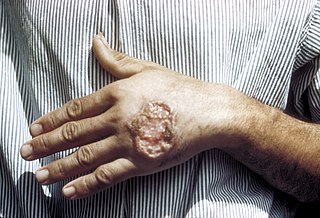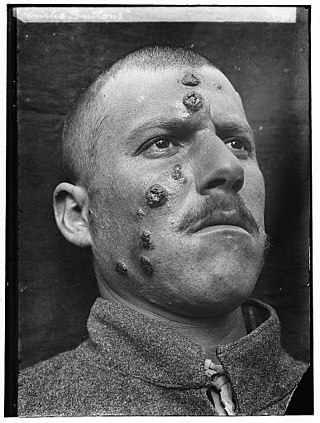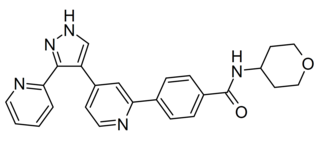
Leishmania is a parasitic protozoan, a single-celled organism of the genus Leishmania that are responsible for the disease leishmaniasis. They are spread by sandflies of the genus Phlebotomus in the Old World, and of the genus Lutzomyia in the New World. At least 93 sandfly species are proven or probable vectors worldwide. Their primary hosts are vertebrates; Leishmania commonly infects hyraxes, canids, rodents, and humans.

Leishmaniasis is a wide array of clinical manifestations caused by parasites of the trypanosome genus Leishmania. It is generally spread through the bite of phlebotomine sandflies, Phlebotomus and Lutzomyia, and occurs most frequently in the tropics and sub-tropics of Africa, Asia, the Americas, and southern Europe. The disease can present in three main ways: cutaneous, mucocutaneous, or visceral. The cutaneous form presents with skin ulcers, while the mucocutaneous form presents with ulcers of the skin, mouth, and nose. The visceral form starts with skin ulcers and later presents with fever, low red blood cell count, and enlarged spleen and liver.

Tropical medicine is an interdisciplinary branch of medicine that deals with health issues that occur uniquely, are more widespread, or are more difficult to control in tropical and subtropical regions.

Phlebotomus is a genus of "sand flies" in the Diptera family Psychodidae. In the past, they have sometimes been considered to belong in a separate family, Phlebotomidae, but this alternative classification has not gained wide acceptance.

Cutaneous leishmaniasis is the most common form of leishmaniasis affecting humans. It is a skin infection caused by a single-celled parasite that is transmitted by the bite of a phlebotomine sand fly. There are about thirty species of Leishmania that may cause cutaneous leishmaniasis.

Visceral leishmaniasis (VL), also known as kala-azar or "black fever", is the most severe form of leishmaniasis and, without proper diagnosis and treatment, is associated with high fatality. Leishmaniasis is a disease caused by protozoan parasites of the genus Leishmania.

The National Order of Scientific Merit is an honor bestowed upon Brazilian and foreign personalities recognized for their scientific and technical contributions to the cause and development of science in Brazil.

Neglected tropical diseases (NTDs) are a diverse group of tropical infections that are common in low-income populations in developing regions of Africa, Asia, and the Americas. They are caused by a variety of pathogens, such as viruses, bacteria, protozoa, and parasitic worms (helminths). These diseases are contrasted with the "big three" infectious diseases, which generally receive greater treatment and research funding. In sub-Saharan Africa, the effect of neglected tropical diseases as a group is comparable to that of malaria and tuberculosis. NTD co-infection can also make HIV/AIDS and tuberculosis more deadly.
Leishmania braziliensis is a Leishmania species.
Mayaro virus disease is a mosquito-borne zoonotic pathogen endemic to certain humid forests of tropical South America. Infection with Mayaro virus causes an acute, self-limited dengue-like illness of 3–5 days' duration. The causative virus, abbreviated MAYV, is in the family Togaviridae, and genus Alphavirus. It is closely related to other alphaviruses that produce a dengue-like illness accompanied by long-lasting arthralgia. It is only known to circulate in tropical South America.
The London Declaration on Neglected Tropical Diseases was a collaborative disease eradication programme launched on 30 January 2012 in London. It was inspired by the World Health Organization roadmap to eradicate or prevent transmission for neglected tropical diseases by the year 2020. Officials from WHO, the World Bank, the Bill & Melinda Gates Foundation, the world's 13 leading pharmaceutical companies, and government representatives from US, UK, United Arab Emirates, Bangladesh, Brazil, Mozambique and Tanzania participated in a joint meeting at the Royal College of Physicians to launch this project. The meeting was spearheaded by Margaret Chan, Director-General of WHO, and Bill Gates, Co-Chair of the Bill & Melinda Gates Foundation.
Sabin Vaccine Institute (Sabin), located in Washington, D.C., is a nonprofit organization promoting global vaccine development, availability, and use. Through its work, Sabin hopes to reduce human suffering by preventing the spread of vaccine-preventable, communicable disease in humans through herd immunity and mitigating the poverty caused by these diseases.

Lutzomyia longipalpis is a species complex of sandfly belonging to the family Psychodidae. This species is primarily present in Central and South America, but has also appeared in Mexico. There have been reports of L. longipalpis as far south as Argentina, as they are found in a wide variety of ecological conditions. Both males and females feed on sugars from plants and aphids, but only adult females feed on the blood of other mammals. The species has recently begun appearing in urban areas throughout Brazil, and serves as a key vessel for the propagation of the parasite Leishmania infantum. The presence of these flies appears to be strongly correlated to the presence of domestic chickens in Latin America. The first major urban outbreak of the lethal Visceral leishmanias epidemic was detected in Teresina, Piauí State in the early 1980s following a massive planting of acacias.
Dionicia Gamboa is a Peruvian parasitologist and professor at Institute of Tropical Medicine Alexander von Humboldt, Cayetano Heredia University. Her research focusses on Plasmodium vivax, a major malaria parasite species in South America.
World NTD Day is an awareness day for addressing neglected tropical diseases (NTDs).
Kala azar in India refers to the special circumstances of the disease kala azar as it exists in India. Kala azar is a major health problem in India with an estimated 146,700 new cases per year as of 2012. In the disease a parasite causes sickness after migrating to internal organs such as the liver, spleen and bone marrow. If left untreated the disease almost always results in the death. Signs and symptoms include fever, weight loss, fatigue, anemia, and substantial swelling of the liver and spleen.
Phlebotomus argentipes are a species of sandfly in genus Phlebotomus in the Indian subcontinent They are notable as a vector for Leishmania donovani, the parasite which causes leishmaniasis.

GW 788388 is a synthetic compound which acts as a potent and selective inhibitor for TGF beta receptor 1. It has applications in research into various disorders such as liver, kidney and heart disease, and potential antiviral properties.









